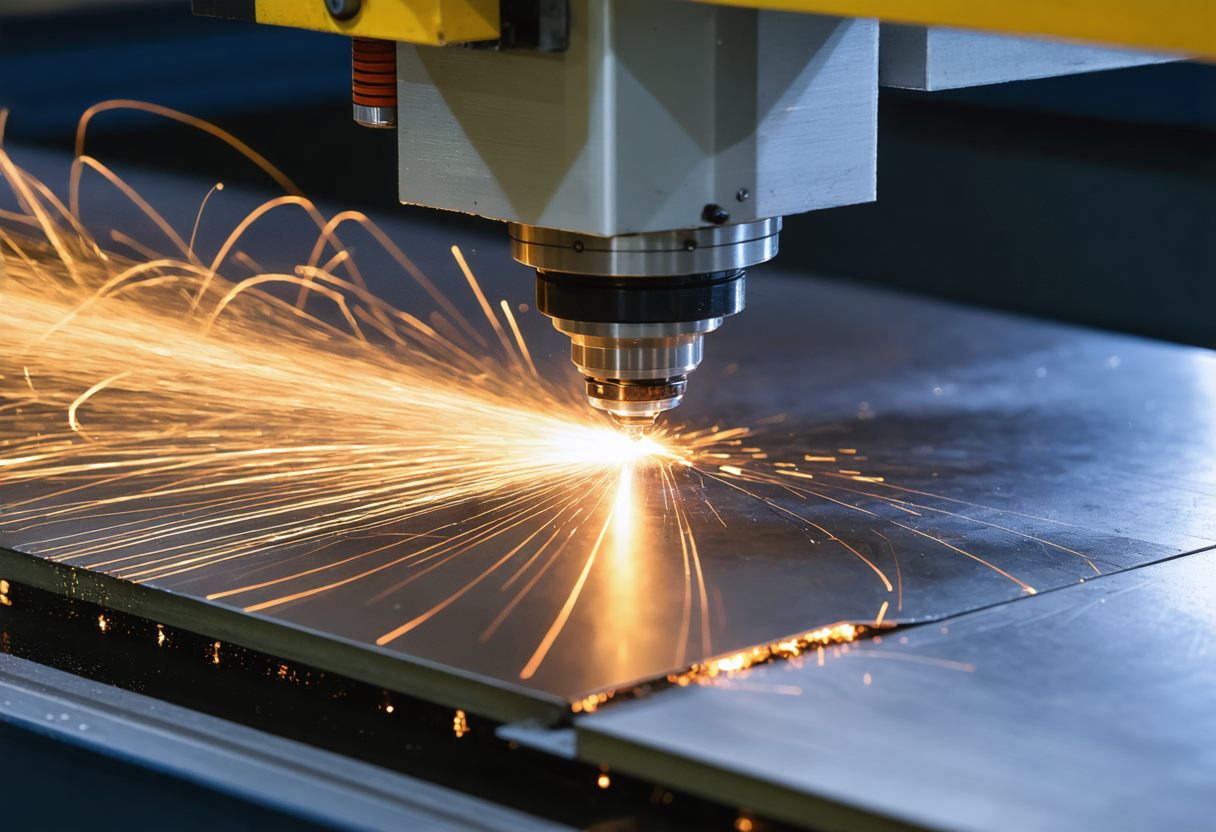
Ever found yourself mesmerized by the precision of a laser cutting 1through metal? Hi, I’m Chen, and lasers have been my passion for over a decade.
A CNC laser cutting machine is a device that uses a focused laser beam, guided by computer numerical control, to cut and shape materials with high precision. It transforms digital designs into physical products by melting, burning, or vaporizing material along a programmed path.
CNC laser cutting machines can replicate intricate designs with high precision.True
The guided laser beam controlled by computer numerical control (CNC) enables these machines to follow complex digital designs accurately, resulting in precise cuts.
CNC laser cutting machines operate primarily through physical contact with the material.False
CNC laser cutting machines use a focused laser beam to cut materials, which means they operate without direct physical contact, relying instead on heat to cut through materials.
Intrigued? Let’s delve into how this technology works.
How does the CNC laser cutting machine work?
Picture a pen that’s guided by a computer, but instead of ink, it uses a laser that can slice through metal.
A CNC laser cutting machine operates by focusing a laser beam onto a material, which heats it to the point of melting or vaporization. The CNC system precisely controls the movement, allowing for intricate cuts and patterns with minimal waste.

The Mechanics Behind the Magic
At its core, the machine combines laser technology with CNC precision to execute complex designs effortlessly.
Key Components
- Laser Source: Generates the laser beam.
- CNC Controller: Directs the laser’s path based on the digital design.
- Optics: Focuses the laser onto the material.
- Motion System: Moves the laser or the material to create the cut.
Imagine tracing a complex pattern with a pencil, but the pencil is a laser, and the pattern is stored digitally.
How It Works Step by Step
- Design Input: A digital design is created using CAD software.
- Program Conversion: The design is converted into CNC code.
- Material Placement: The material is placed on the cutting bed.
- Laser Cutting: The CNC system guides the laser to cut the material according to the design.
This process allows for high repeatability and precision, making it ideal for mass production.
What are the unique usages of a laser cutting machine?
You’d be surprised where laser cutting technology is making an impact.
Laser cutting machines are used in various industries, from aerospace to fashion, enabling the creation of complex parts, artistic designs, and precise components that traditional cutting methods can’t achieve.

Beyond Industrial Applications
Laser cutting 2isn’t just for heavy industry; it’s also a favorite among artists and designers.
Unique Applications
- Medical Devices3: Crafting precise components for surgical tools.
- Jewelry Making: Designing intricate patterns in metals.
- Architecture: Creating detailed models and prototypes.
- Automotive: Producing custom parts and prototypes.
It’s like having a universal tool that can handle both heavy-duty tasks and delicate artistry.
Real-World Examples
- Fashion Industry: Cutting fabrics with precision for unique designs.
- Electronics: Cutting circuit boards with intricate pathways.
- Signage: Crafting detailed signs with complex fonts and logos.
This versatility makes laser cutting machines invaluable across various sectors.
What is the advantage of a laser cutting machine?
Why are more industries turning to laser cutting?
Laser cutting machines offer unmatched precision, speed, and versatility, reducing production times and costs while improving product quality. They can handle complex designs and a variety of materials with ease.

Efficiency and Precision Combined
These machines streamline processes that used to require multiple tools and steps.
Advantages
- High Precision: Achieve intricate designs with minimal error.
- Speed: Faster cutting speeds compared to traditional methods.
- Versatility: Cuts a wide range of materials, including metals, plastics, and wood.
- Reduced Waste: Precision cutting minimizes material waste.
- Low Maintenance: Modern lasers require less upkeep.
Imagine upgrading from a handsaw to a laser scalpel—everything becomes faster, cleaner, and more precise.
Comparative Table
| Aspect | Traditional Cutting | Laser Cutting |
|---|---|---|
| Precision | Moderate | High |
| Speed | Slow | Fast |
| Material Waste | Higher | Lower |
| Complexity | Limited | Complex shapes easy |
| Maintenance | Regular | Less frequent |
The benefits are clear, making laser cutting an attractive option for businesses of all sizes.
Which laser is most widely used for laser cutting? Why?
Not all lasers are created equal; one stands out in the industry.
Fiber lasers are the most widely used for laser cutting due to their high efficiency, excellent beam quality, and low maintenance requirements. They are especially effective for cutting metals.

The Rise of Fiber Lasers
Fiber lasers have become the go-to choice for many manufacturers.
Reasons for Popularity
- Energy Efficiency4: They convert electrical energy to laser light more efficiently.
- Beam Quality5: Produce a fine, high-intensity beam for precise cuts.
- Durability: Robust design with longer lifespan.
- Cost-Effective: Lower operating costs over time.
Comparison with Other Lasers
| Laser Type | Efficiency | Beam Quality | Maintenance | Ideal For |
|---|---|---|---|---|
| Fiber Laser | High | Excellent | Low | Metals |
| CO2 Laser | Moderate | Good | Moderate | Non-metals |
| Crystal Laser | Low | Good | High | Specialized uses |
Choosing a fiber laser is like picking a reliable, fuel-efficient car—it gets the job done effectively while saving you money in the long run.
Conclusion
CNC laser cutting machines are revolutionizing industries by offering precision, efficiency, and versatility. Whether you’re in manufacturing, design, or engineering, understanding this technology can unlock new possibilities for innovation.
-
This link on "laser cutting" provides valuable insights into the technology behind how lasers achieve such high precision in metalwork, helping you better understand the capabilities and applications of this fascinating technology.
-
The link on "laser cutting" helps readers understand how laser technology is used in creative industries beyond its industrial roots. This can give you a fresh perspective on the artistic possibilities that this precise technology unlocks.
-
The link on "Medical Devices" explains how laser cutting is crucial in crafting delicate, precise components for medical equipment. This insight emphasizes the precision and reliability of laser technology in healthcare, underscoring its diverse utility.
-
The link on "Energy Efficiency" provides context on how fiber lasers utilize electrical energy more efficiently than other lasers, which can be important for users concerned with sustainability and long-term operating costs.
-
The link on "Beam Quality" explores the significance of high-quality beams in achieving precise cuts. This link will help you understand how fiber lasers produce a more focused, intense beam, which is crucial for applications that demand fine, detailed cuts.




